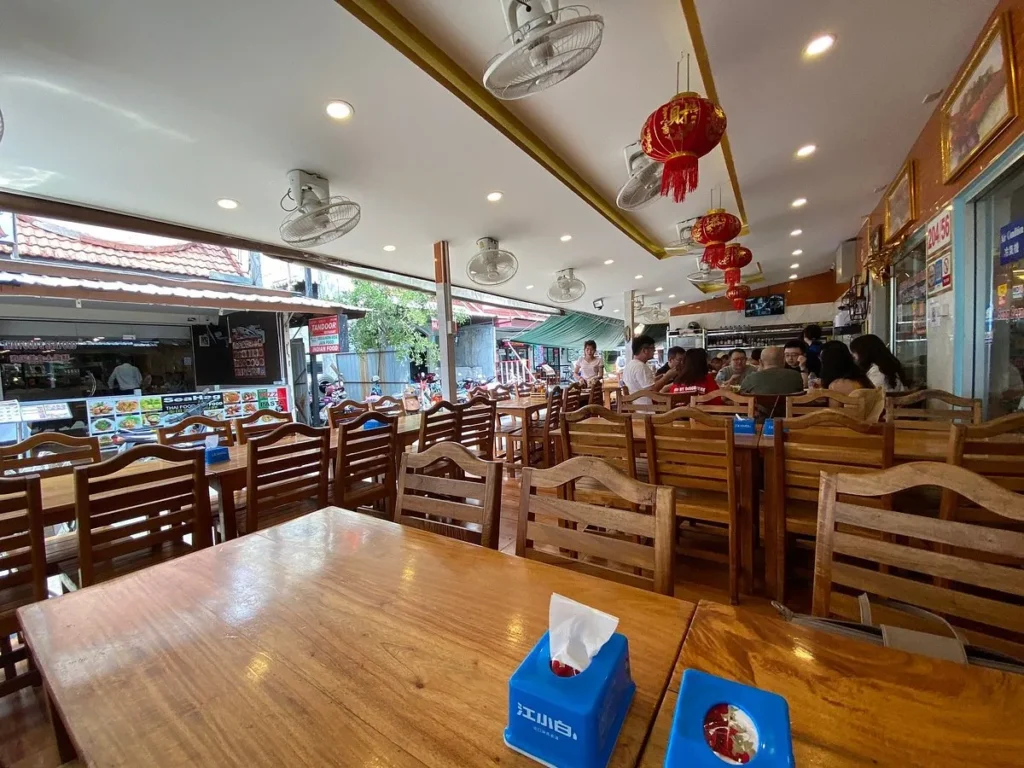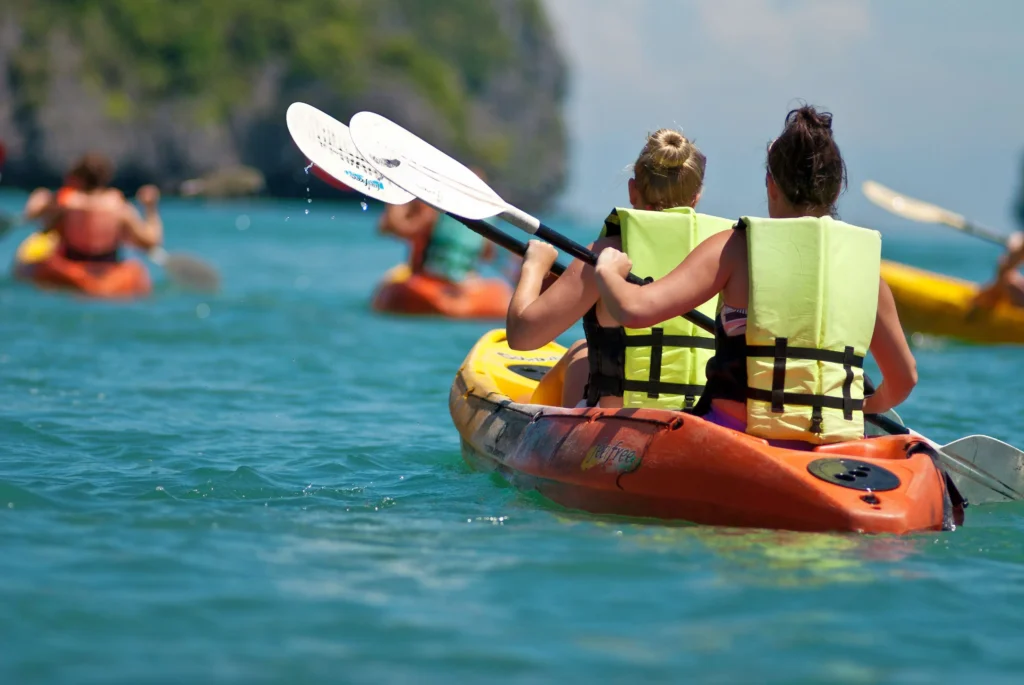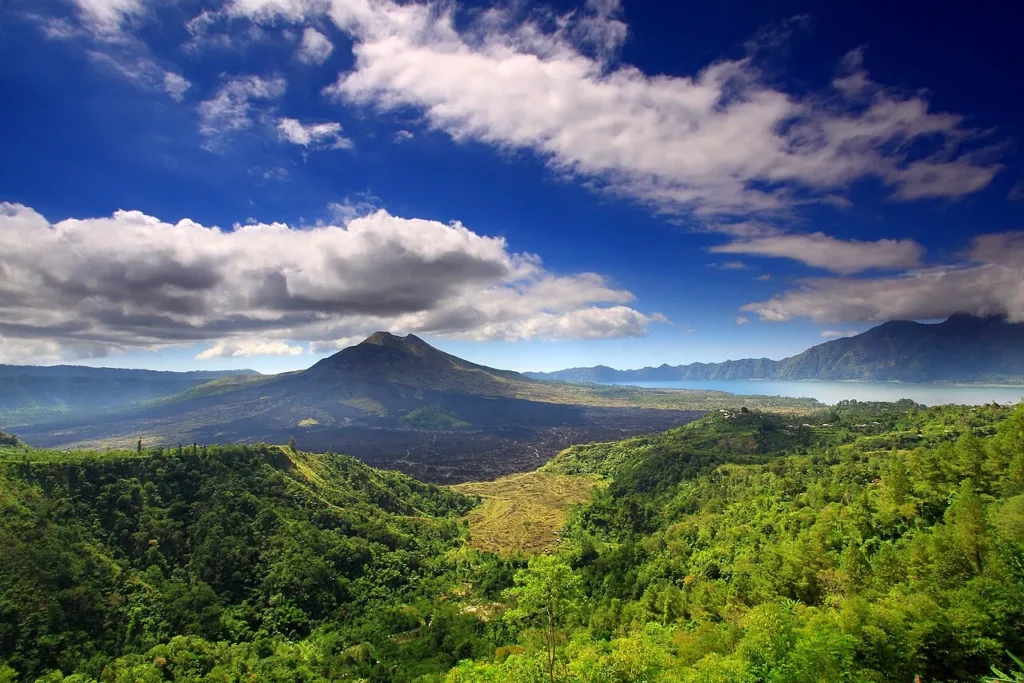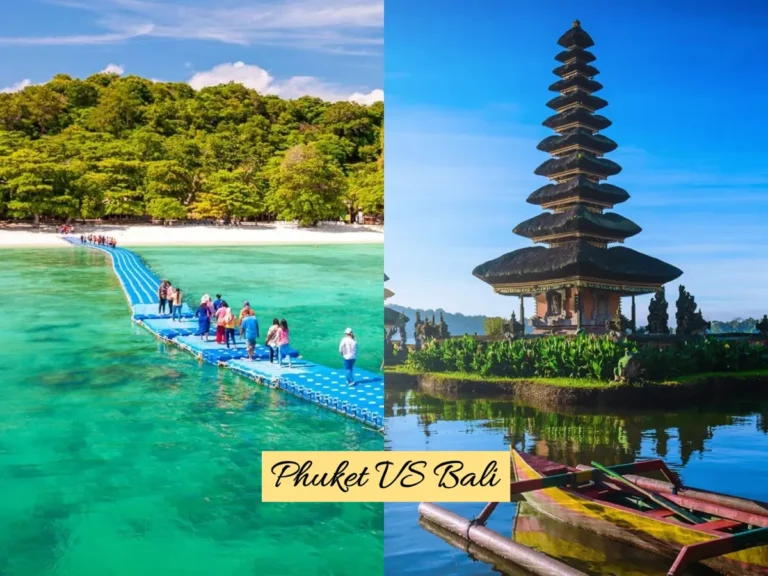In the vast playground of Southeast Asia, where island paradises sprout from azure waters like mushrooms after rain, two heavyweights continually battle for the traveller’s heart (and precious vacation days).
Phuket and Bali stand like titan boxers in opposing corners of the tropical ring. They flex their beaches and cultural credentials while vacationers worldwide sit ringside, clutching their passports and wondering which deserves their hard-earned escape time. Lonely Planet offers insights into the differences between Bali and Phuket.

Phuket
Phuket defies stereotypes without making a fuss. This Thai paradise blends tropical allure with the vibrant buzz. It creates an enticing cocktail of experiences that appeals to all travellers.
Northern Phuket

Phuket’s renowned for its powdery white beaches that seem designed by a higher power specifically for Instagram posts. The northern shores boast gems like Hat Surin, the seemingly endless Hat Bang Thao, and the wilder Hat Layan.
Nature enthusiasts gravitate toward the protected Sirinat National Park, home to Hat Nai Yang, Hat Mai Khao, and Hat Nai Thon, where development takes a respectful back seat to natural beauty.
In the island’s southern reaches, tranquil Hat Rawai attracts those seeking rustic seafood restaurants and kitesurfing opportunities.
Nearby Hat Nai Han offers pristine sands, while Laem Phromthep (Promthep Cape) serves as the stage for mesmerising sunsets that draw crowds to witness the daily spectacle of the sun melting into the jade-hued Andaman Sea.
Culinaries

Phuket’s food scene stands among Thailand’s most compelling, born from centuries of cultural fusion between Southeast Asian and Chinese influences—a heritage known locally as Baba culture.
The island’s capital, Phuket Town, serves as the epicentre of this gastronomic wonderland, with its candy-colored Sino-Portuguese architecture setting the stage for culinary exploration.
Food aficionados can dive into the Lock Tien food court for classics like mee hokkien and freshly made spring rolls served unpretentiously at plastic tables.
Morning rituals might include savouring flaky roti topped with fried eggs at popular breakfast spots along Thalang Road. Local institutions like Mee Ton Poe, Kopitiam, and Raya deliver authentic flavours in settings ranging from humble to historic.
The island also caters to fine dining enthusiasts with establishments like Acqua, where superstar chef Alessandro Frau crafts contemporary Sardinian delights, or Michelin-starred PRU in northern Phuket. Coffee culture thrives too, with spots like The Shelter Coffee and Bookhemian rivalling the renowned café scene of Chiang Mai.
Adventure Activities

Phuket welcomes all travelers—from solo female adventurers to families and groups of friends. Activities abound, from beachfront yoga sessions to diving excursions, visits to Buddhist temples like the 150-year-old Wat Chalong, or testing one’s mettle in muay thai boxing.
Day trips reveal natural wonders beyond the main island. Kayaking or paddleboarding through Ao Phang-Nga Marine National Park offers intimate encounters with dramatic limestone karst formations. The iconic Ko Phi-Phi islands remain accessible, with Maya Bay now open under conservation-minded restrictions.
Hikers can test their endurance on the jungle-traversing climb to the 45-meter Big Buddha in the Nakkerd Hills or explore trails through the rainforests of Khao Phra Thaew Royal Wildlife and Forest Reserve, where the Gibbon Rehabilitation Project does vital conservation work.
Bali

While some dismiss Bali as overcrowded and overdeveloped, others rightfully celebrate it as among the world’s most beautiful islands. This “Island of the Gods” balances tourism with traditions in a way few destinations manage.
Culture and Coastlines
What truly distinguishes Bali is its deeply rooted cultural identity. The island’s vibrant spiritual landscape features a colourful pantheon of gods, demons, ghosts, and witches that infuse daily life with ritual and meaning, creating one of the world’s most culturally fascinating environments.
Bali’s coastline offers remarkable diversity. The Bukit Peninsula and Nusa Dua feature dreamy, palm-shaded white sand beaches that fulfil tropical fantasies, protected by local laws preventing buildings from rising higher than the palm trees.
For those seeking different coastal energy, romantic volcanic beaches provide miles of shimmering black sand, often devoid of other tourists.
Wave-chasers gravitate toward the dramatic south coast for world-class surfing, while the sheltered northern shores offer calmer waters ideal for spotting dolphins, turtles, and diverse marine life.
Excursions

Venturing inland reveals Bali’s volcanic highlands, offering adventures beyond sunbathing.
The sunrise climb up 1,717-meter Gunung Batur ranks among the island’s most popular excursions, rewarding early risers with breathtaking panoramic views.
Active travellers can cycle downhill for 40 kilometres, navigate white-water rapids, or trek through lush jungles. In the island’s unspoiled western region, unique experiences include walking alongside pink buffalo or visiting what might be the world’s most photogenic traditional fishing fleet.
North Bali’s arid hillsides support unexpected agricultural diversity, including cashews, dragon fruit, and even vineyards. Meanwhile, the southern slopes feature the iconic terraced rice paddies, sometimes extending dramatically right to the ocean’s edge.
Affordability

Bali’s accommodation options span the full spectrum. Luxury seekers can indulge at five-star resorts like Raffles and Four Seasons, which occupy lush grounds with direct beach access. Design enthusiasts appreciate cutting-edge boutique properties like Lost Lindenberg and Nirjhara.
Perhaps most remarkably, budget travellers can still secure simple, comfortable rooms with private balconies overlooking tropical gardens for under $10 per night, complete with breakfast—a value proposition increasingly rare in popular destinations.
West Bali

At roughly 10 times Phuket’s size, Bali offers ample opportunity to escape the crowds.
The island’s western third remains largely overlooked by visitors, preserving an unspoiled paradise where West Bali National Park houses deserted beaches where wild deer trot through shallow waters and jungle-covered hills shelter wildlife like hornbills, flying foxes, and langur monkeys.
Bottom Line
As our journey through these twin paradises concludes, we find ourselves exactly where we started!
Phuket offers Thai hospitality wrapped in soft white beaches with a culinary bow on top, while Bali presents a spiritual sanctuary with diverse landscapes and experiences that could fill a lifetime of exploration.
Perhaps the true answer lies not in choosing one over the other, but in recognising that both deserve a place on your travel bucket list—preferably with enough time between visits to forget how much sunscreen you had to apply daily!
Stay tuned with us. Further, follow us on social media for the latest updates.
Join us on Telegram Group for the Latest Aviation Updates. Subsequently, follow us on Google News

